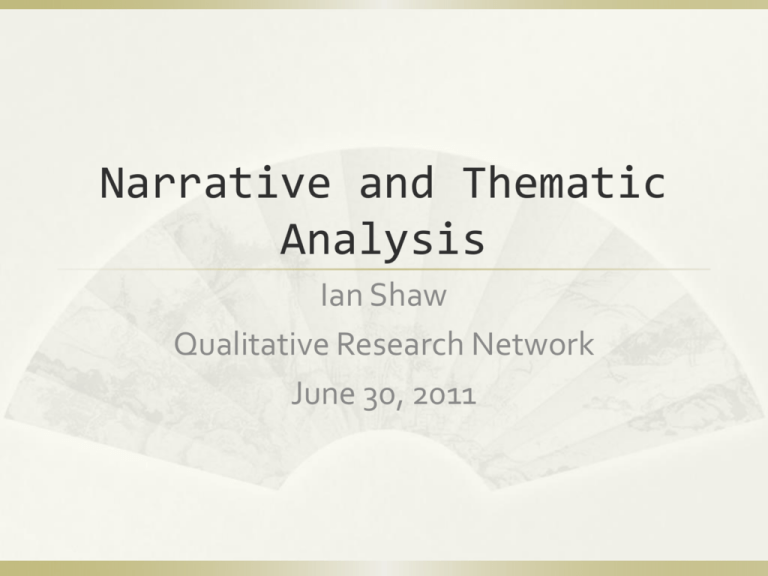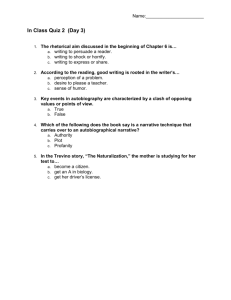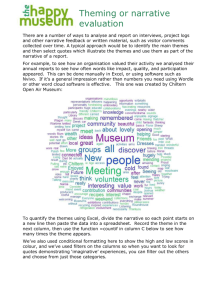2011-06-30 Ian Shaw Thematic Analysis powerpoint (MS
advertisement

Narrative and Thematic Analysis Ian Shaw Qualitative Research Network June 30, 2011 Themes and narratives Themes – there are different themes, plural Narrative – singular, one narrative Themes – the text is disaggregated. Different meanings Narrative – the text seen as a whole More on themes and narratives Themes – our interest is in ideas from within cases compared across different cases as the unit of analysis Narrative - our interest is comparing cases against each other as a whole Themes – analyzing the content; what is being said Narrative – analyzing how it has been said What and How in Thematic Analysis I’m not good at interviews - sorry, you’re now listening to me thinking out loud - I’m not very good at interviewing, never think I’m very good at interviewing people, which I’ve done a lot of times and again it’s because I have this thing I have to follow and that I feel I’m not free to ask people... I’m terrified I’ll forget something. It’s more serious asking because – when you’re a social worker it is (a) gaining people’s trust and then you go back, it’s all a jigsaw, layers of things you find, so you don’t have to find it out the first time. In this one I feel I have to find everything on this one interview and that has made me freeze. I found that difficult. Applied disciplines Many qualitative practitioners struggle with the dissonance invoked by the assumed minddependence of all social knowledge claims in the face of the contextual (as well as personal, ego-related) demands to “get it right”, to “find out what’s really going on in this setting”. (Greene, 1996: 280) Distinctions Oral/written Naturally occurring/solicited Narrative as resource/topic The told, the teller, the audience, their relationship to one another (always a coconstruction – Riessman and Quinney) Characteristics of narrative Narrator tells story as temporal and logical (’sequence and consequence’ Riessman and Quinney, p394) Rarely simple chronology Dynamic – shaped by past tellings Performative Cultural variations in forms of stories ‘Bridge cultural history with personal biography’ Plummer, 2001 More on natural/researched distinction The everyday naturalistic. ‘Simply there’ and not shaped by the social scientist. Autobiography, telephone conversations, reminiscences. Researched: ‘Seduced, coaxed and interrogated out of subjects’ (Plummer) Reflexive, recursive life stories: self aware life stories. Eg Autoethnography Narratives and Methods Visual methods – eg Laura Lorenz’ challenging research using photo-elicitation in a narrative study with people who had suffered brain injury. Documents – eg autobiography – I had the amazing good fortune a few weeks ago, when working in the university archives at Chicago, to stumble across an unknown unpublished autobiography of Stuart Queen who worked on the interface of sociology and social work through a large part of the last century. Ethnographic (and auto-ethnographic) accounts, field logs. Themes in Narratives How can we talk in terms of themes when we want to present narrative analysis? keep the story intact by theorizing from the case rather than from component themes or categories across cases ‘Why do you think you got arthritis?’ Bill Gill Betty Cleaning the narrative Drawn from multiple interactions, ‘It has been assembled…to demonstrate two things: one, that clinical interactions are a series of social texts; and two, when studied closely, such interactions are replete with everyday acts of power that must be attended to in social work research into clinical practices… (I)t is my hope that the writings of experience in this article can confront the fictions, fantasies, narratives, explanations, and signs that allow patients in pain a limited number of transgressions.’ (Phillips, 2007: 201). Narrative structures: Labov Abstract: what is the story about? Orientation: what is the context for the story? Complicating actions: What carries the action of the story forward? Evaluation: What is the point of the story? Resolution: What finally happened? Coda: How does the narrator signal that the story is over? More on resource and topic Resource: where the text is read for what it tells us about the subject matter of the story Topic: where the story tells us about the processes through which a life is constructed Text: where the story is seen as part of the conventions of a culture More on story as narrative text It will have A plot. The dynamic tension that holds the story together and moves it along Episodes. Autobiographical events central to the story Themes Characters A point of view from which the story is told More on narrative forms Moral tales Survival in adversity Autobiography Coming out story Re-evaluating the past Becoming a Sociologist in 1909 Not a simple chronology. Conscious story-telling, and of something that was life-changing. An epiphany (Denzin). Opens with passive – ‘was decided’ – and then ‘by accident’. The implicit idea of happenstance and good fortune runs through it. Eg ‘I decided to take a chance’ and ‘This might easily have driven me away from Sociology, but…’. Rhetorical devices – e.g. listing. The coda ‘So in the course of one semester I made up my mind to be a sociologist and to attend the University of Chicago…’ Mrs. Hunter I met a woman up at the laundry and I just was… oh I was desperate! I just burst out crying. I thought I was on my own actually, it was late at night. And a woman started talking to me, a complete stranger… I poured out my life to her. You know how you meet someone and you talk to them. She said she’d been to the FWA and she knew others who had been there too. After telling me her case, she said they were bound to help me – to give me financial help – that it was a dot on the cards… And I thought to myself, well, I will go. Narrative Analysis as Professional Practice The use of the present tense (although there is some variation in verb tenses) suggests how telling the story takes the speaker back into the immediacy of the experience. ‘Bleak depression’ is experienced as lack of control. Not being able to express in words - ‘kind of hard to put into words, I never really could when it was going on’. Sense of velocity, seen here in the lack of full stops. ‘I was running sort of like wide open, 90 miles an hour down a dead end street’; ‘running right on the edge and I don’t know on the edge of what’. More on ‘Bleak Depression’ The strangeness and doom-laden character of the experience – ‘…and I don’t know on the edge of what’. The music references. The narrative poses the question whether some life-moments that have meaning for us take on greater intensity of meaning, perhaps even including creativity? The music reference is an allusion to a song associated with Bob Dylan, which includes: Warning signs are flashing ev’ry where, but we pay no heed ‘Stead of slowing down the pace, we keep a pickin’ up speed Disaster’s getting closer ev’ry time we meet Going ninety miles an hour down a dead end street References [1] Lorenz, L. S. (2010a). Discovering a new identity after brain injury. Sociology of Health & Illness 32 (6): 862879. Lorenz, L. S. (2010b). Visual metaphors of living with brain injury: exploring and communicating lived experience with an invisible injury. Visual Studies, 25 (3): 210-223. Mayer, J and Timms, N (1970) The Client Speaks London: Routledge and Kegan Paul. Phillips, C (2007) ‘Pain(ful) subjects: regulated bodies in medicine and social work’ Qualitative Social Work 6 (2): 197-212 References [2] Queen, S A (nd) Sixty Years of American Sociology as Viewed by a Participant Observer Stuart Alfred Queen. Papers [Box 1 Folder 1]. Special Collections Research Center, University of Chicago Library. Riessman, C. K. (2008) Narrative Methods for the Human Sciences Thousand Oaks: Sage Publications. Shaw, I (2011) Evaluating in Practice Aldershot: Ashgate Wells, K (2011) Narrative Inquiry New York: Oxford University Press Williams, G (1984) ‘The genesis of chronic illness. Narrative reconstruction’ Sociology of Health and Illness 6 175-200 [note that you will not find this in either the e-journals or hard copy, so will need to pay your 2.00 for ILL]





